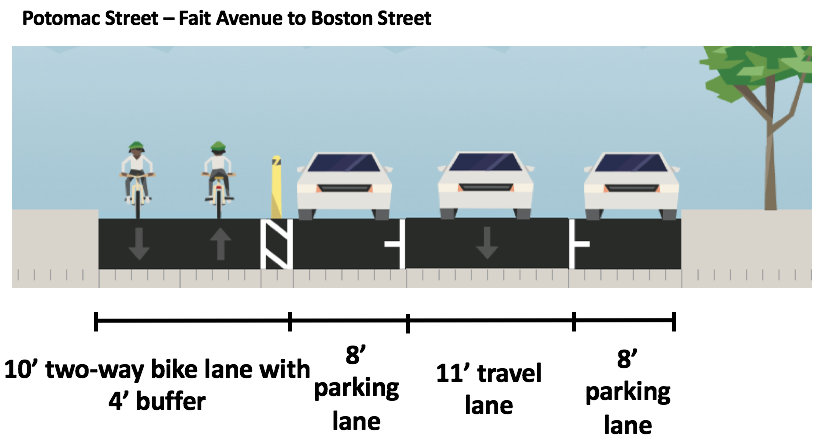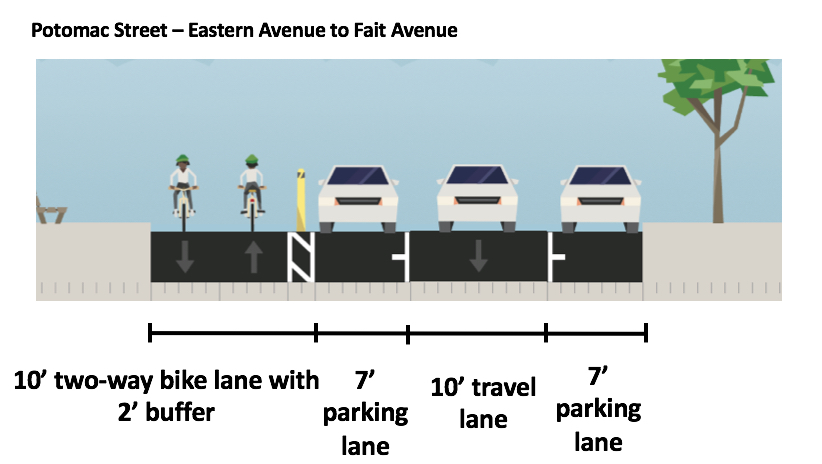The original South Potomac Street design was a two-way, parking protected bike lane consistent with Baltimore City's adopted NACTO Urban Bikeway Design Guide. It was an all-ages, high-quality protected bike lane.
Bikemore was supportive of an initial requested change by the Baltimore City Fire Department that would have reduced the portions from Eastern to Fait to the narrowest lanes NACTO recommends in constrained settings, allowing a wide, 12 foot travel lane on South Potomac. While we feel a lane of that width is inconsistent with the goal of slower, safer traffic on neighborhood streets, it was a compromise that still maintained the bicycle lane as all-ages.
The new design is not an all-ages facility. It is not a high-quality facility.
The section from Eastern to Fait will be moved adjacent to the travel lane, and will be striped with an unprotected buffer. This introduces two-way bike traffic in an unprotected setting, and gives a person driving a car the visual appearance of a 20+ foot roadway. Without frequent speed humps and other traffic calming measures, this will create a roadway where people driving cars will speed and possibly encounter people riding bicycles head-on. This is not low-stress, it's not all-ages, and without traffic calming measures, is unsafe.
FHWA guidance for a one-way facility
The section from Fait to Boston narrows the two-way parking protected bike facility to just 7 feet with a 1 foot buffer.
The narrowest two-way facility NACTO guidelines recommend in constrained settings is 8 feet with a 2 foot buffer. FHWA guidance is a recommended 12 feet for a two-way facility with a required 3 foot buffer if parking protected.
This is not a two-way protected bike lane.
Even as a one-way protected lane, it would fail to meet recommended conditions from FHWA, as the buffer is too narrow.
Not only do these design changes make the bike lane unusable for people of all ages and backgrounds, they jeopardize funding.
This facility was built using state and federal grants that require designs to conform to federal, state, and local street design guidebooks, including the FHWA Separated Bike Lane Planning and Design Guide. The original design conformed to these guidebooks. The new design does not.
It is likely that the re-design will need to go before State Highways Administration for a review in order to keep the dollars already expended on the project and expend further dollars. If this is rejected, Baltimore City may be on the hook to return expended dollars in addition to using local dollars to construct the new design, since it fails to meet guidelines.
We can't back this.
We cannot back potentially paying back grant dollars with local dollars and spending even more local dollars on top of that to design and install a worse facility that makes the street less safe for all road users.
Every local dollar spent on this imaginary problem is a local dollar that the city said they didn't have to invest in bicycle infrastructure in other neighborhoods. The West Baltimore Bike Boulevards project has been held up for a year because the city couldn't commit the funds to get the project done. But now there's suddenly local money available to cave to unreasonable demands in Canton?
Spend the money on facilities elsewhere.
We know the city has money available for bike facilities, because they have suddenly come up with it to make this change in Canton. We don't believe any change should be made. But if the Mayor's Office is committed to tearing out this perfectly good bike facility, they should revert the street back to the original configuration and use any money they allocated to a new, worse design on building out bicycle infrastructure wanted and needed by other communities. We can come back to Potomac Street once this fire access issue is fully sorted out. There's no need to build inferior infrastructure in the meantime.
There are two ways to take action today!
Register to attend our Shifting Power workshop, our new program providing livable streets advocacy training to everyday citizens.
Tell your elected officials that you are against the Mayor's Office decision to redesign the Potomac Street bike lane, and that you support safe streets for all.










